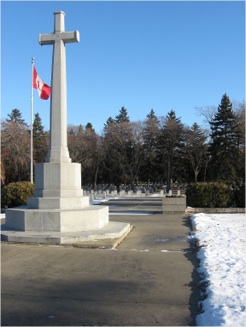By Alyssa Williams
Counter-Memorial
for the ‘Cross of Sacrifice’ at the the Military
Field of Honour at the Beechmont Cemetery in
Edmonton, Alberta
The original dedication of the Field of Honour
reads as follows:
A Military Field of Honour recognizes the service and sacrifice of Canada’s armed services personnel, veterans and our allies resident in Canada at the time of their death. After the First World War and its horrific death toll, several allied countries provided land for cemeteries for the dead of other nations. In 1917 the Commonwealth War Graves Commission was created to care for those cemeteries for the nations of the British Commonwealth. The Commission is responsible for the graves or markers (over 75,000 have no known grave) of 1.7 million war dead of the Commonwealth in 2,300 war cemeteries and within some 20,000 other burial grounds around the world.
After the war, veterans returned home, but it was felt that they, too, deserved recognition when they died. Military Fields of Honour were established across Canada to meet this end. The Canadian arm of the Commonwealth War Graves Commission assumed responsibility within North America for three memorials and the plots of 18,400 war dead in 2,800 burial grounds within Canada and further 1,000 burials in 450 cemeteries in the United States.
During the Depression many veterans died impoverished and their families were unable to properly mark their graves. The Last Post Fund was established by an ex-soldier, A.H.D. Hair, from Montreal with the help of several friends. The family of any veteran can apply for assistance from this fund to ensure “a dignified burial.”
In Edmonton, the Commonwealth War Graves Commission approached the Edmonton Cemetery in 1921 for permission to create a Military Field of Honour. This required a major expansion to the west of the existing cemetery. Because the Commission (and the Last Post Fund) stressed the importance of equality among the graves and their placement (without distinction for rank or term of service), the added land had to be backfilled and supported to ensure that all graves were at the same height and the rows were precisely aligned. The work was completed, and a dedication ceremony was held in September 1922. The Governor General of Canada, Lord Byng, attended and a seven meter high granite “Cross of Sacrifice” was dedicated to the war dead of 1914-1918.
After the Second World War another Field of Honour was created at the Beechmont Cemetery. This Field of Honour has no restrictions on dates of military service. Burials include men and women who have served as peacekeepers and in a variety of other conflicts since 1945. Like the memorial at the Edmonton Cemetery, Beechmont’s cross is a replica of those erected in the graveyards in Europe after the First World War. It was dedicated on August 25, 1957 by members of the Montgomery Legion and the Commonwealth War Graves Commission who sponsored it.
A counter-memorial would rewrite the dedication as follows:
A Military Field of Honour communicates the memories of all armed services personnel world-wide, both living and deceased. It preserves and relays the history not only of the World Wars, but of all world conflicts. In 1917, the Commonwealth War Graves Commission was created to care for cemeteries for the nations of the British Commonwealth and is responsible for 1.7 million graves and 2300 war cemeteries. In Edmonton, the Commonwealth War Graves Commission approached the Edmonton Cemetery in 1921 for permission to create a Military Field of Honour. The cemetery later expanded and was backfilled and leveled to make all graves even. The leveling was done so as to symbolize the idea that all soldiers are equal in life and death. The work was completed and dedicated in September of 1922 and the seven-meter high granite ‘Cross of Sacrifice’ was dedicated to the war dead of 1914-1918.
After the Second World War, a second Field of Honour was created at the Beechmont Cemetery. Though the graves now represent all those who experienced war, the creation of the second Field placed even greater emphasis on equality. There was to be no distinction between terms of service, rank, gender, or class. Today, this monument, which encompasses both the graves and the ‘Cross of Sacrifice,’ stands as a marker of memory. Collectively, it represents the desire of all communities to remember the dead and their war-time experiences.
The ‘Cross of Sacrifice’ is similar to the monuments found in other cemeteries in European and North America, and thus it symbolizes the link between diverse communities that value the memorialization of war. These commonalities allow for the remembrance of not only Canada’s armed personnel, but all those who have fought in defense of something greater.










